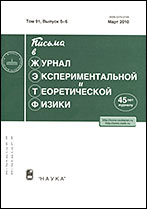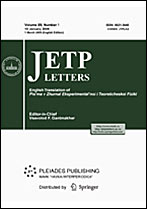|
|
Pis'ma v Zhurnal Èksperimental'noi i Teoreticheskoi Fiziki, 2010, Volume 91, Issue 12, Pages 734–738
(Mi jetpl750)
|
 |
|
 |
This article is cited in 3 scientific papers (total in 3 papers)
CONDENSED MATTER
Long-range chemical interaction in solid-state synthesis: The Kirkendall effect and solid-state reactions in Cu/β-CuZn and Cu/Fe/β-CuZn film systems
V. G. Myagkova, L. E. Bykovaa, G. N. Bondarenkobc, G. V. Bondarenkoa
a L. V. Kirensky Institute of Physics, Siberian Branch of the Russian Academy of Sciences
b Institute of Chemistry and Chemical Technology SB RAS
c M. F. Reshetnev Siberian State Aerospace University
Abstract:
The results of the experimental investigations of the solid-state reaction of Cu with β brass, which is associated with the Kirkendall, in Cu/β-CuZn and Cu/Fe/β-CuZn film systems are reported. It has been shown that the initiation temperature of the solid-state synthesis of α brass at the Cu/β-CuZn interface is about 200°C. The chemically inert Fe barrier layers 420 and 850 nm in thickness between the Cu and β-CuZn films do not suppress the solid-state synthesis of the α brass, but increase the initiation temperature to about 250°C. This behavior indicates that the chemical interaction between the Cu and Zn atoms through the chemically inert Fe layer is long-range. The X-ray photoelectron investigations reveal the migration of Zn atoms from the β-CuZn layer through the Fe barrier to the Cu layer. The results are interpreted under the assumption that the migration of Zn atoms in the Kirkendall is initiated by the strong chemical interaction between the Cu and Zn atoms in the Cu and β-CuZn layers, which is due to the synthesis of α brass, rather than by the diffusion random walk, as is commonly accepted at present.
Received: 14.05.2010
Citation:
V. G. Myagkov, L. E. Bykova, G. N. Bondarenko, G. V. Bondarenko, “Long-range chemical interaction in solid-state synthesis: The Kirkendall effect and solid-state reactions in Cu/β-CuZn and Cu/Fe/β-CuZn film systems”, Pis'ma v Zh. Èksper. Teoret. Fiz., 91:12 (2010), 734–738; JETP Letters, 91:12 (2010), 665–669
Linking options:
https://www.mathnet.ru/eng/jetpl750 https://www.mathnet.ru/eng/jetpl/v91/i12/p734
|


| Statistics & downloads: |
| Abstract page: | 233 | | Full-text PDF : | 84 | | References: | 43 |
|





 Contact us:
Contact us: Terms of Use
Terms of Use
 Registration to the website
Registration to the website Logotypes
Logotypes









